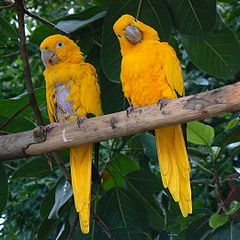An exciting new study has revealed that healthy parrots prefer working for their food to eating from a bowl. Parrots involved in feather-plucking, however, go right to their bowls and show no interest in solving problems that led to food rewards. I think this research is important to all who share their homes with parrots. Some progress was also made in developing a medication for birds that have begun to damage their plumage. I have dealt with feather-plucking even in well-run zoos; it’s a sad and frustrating condition, and I hope that this new work points the way to some solutions.
Busy Minds and Bodies Remain Healthy
Feather plucking is heartbreaking to see, and immensely frustrating to cure. Despite much interest from the parrot-keeping community, foolproof solutions elude us. Feather-plucking and other forms of self-mutilation ruin the lives of countless pet parrots, many of which are eventually turned over to rescue centers, euthanized, or released.
A researcher at the Utrecht University Clinic for Companion Animals in the Netherlands offered African Gray Parrots the option of eating from a bowl or removing food from a pipe lined with holes. Healthy birds invariably ignored the food bowls and went right to work on the pipes. Read More »
 That Bird Blog – Bird Care and History for Pet Birds
That Bird Blog – Bird Care and History for Pet Birds




